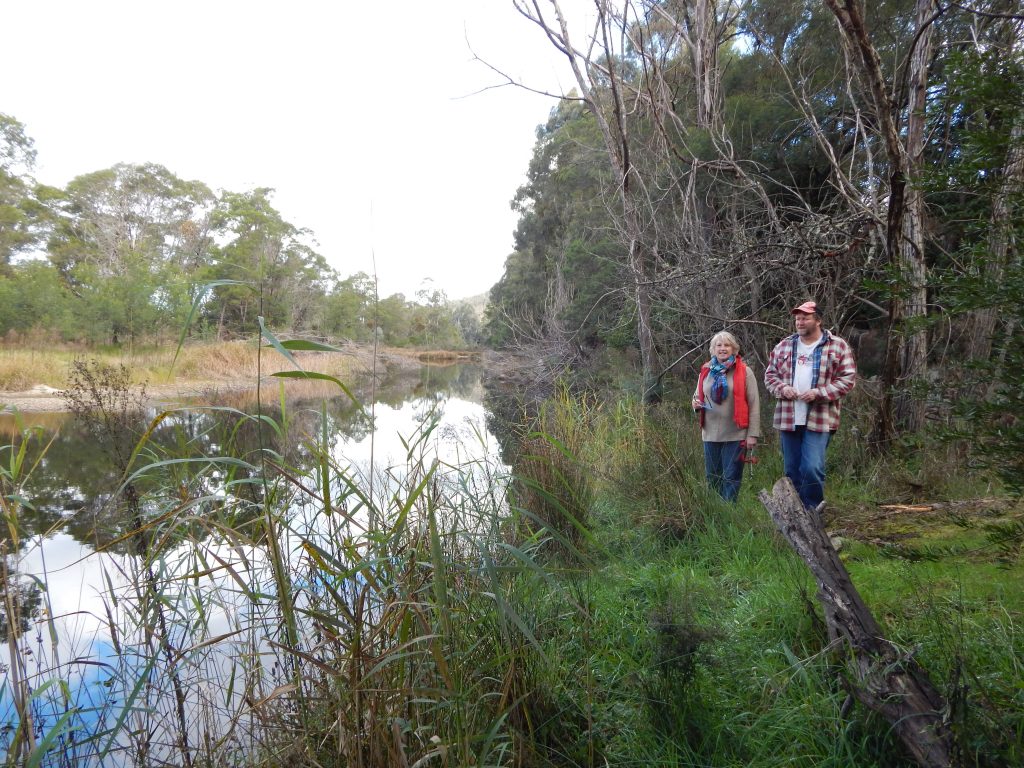“The river is back to where it was when I was a child. I can’t remember it looking as healthy as it is at the moment since I was a young bloke.”
So says Daryl Cameron, a cattle farmer from Noorinbee who grew up on the farm that he and his brother Greg now run.
Back when Daryl was a kid he remembers the river being filled with fallen branches, lots of trees on the banks and plenty of little islands in the middle of the river. “You could get across in your boots without getting your feet wet” he says. Suffice to say that Daryl’s seen a lot of changes on the floodplain over the years.
The Cann River valley is well known for its floods. The area has always been prone to flooding but these days locals tend to refer to just three – ’71, ’78 and ’98, with 1971 being the biggest in living memory.
The ‘71 flood stunned the local farmers, with barely a fence left standing in the valley once the waters had subsided. “The 1971 flood tore the guts out of it” explained Daryl. “I woke up to discover our paddocks were four foot under water and I thought, gee I’ve blown my farming apprenticeship here! I remember there was a pressure wave 15-20 foot high throwing out huge trees over the wave, the force was just unbelievable.”
“Historically, authorities thought they were doing the right thing by deepening and widening the river, straightening it up.” concurs Greg, “but the consequences they weren’t able to predict when that ‘71 flood came was that it just moved so much of the alluvial plain into the river. That’s been the big battle since then.”
The Camerons have been working in partnership with the East Gippsland Catchment Management Authority and its predecessor, the Cann River Improvement Trust, to minimise the impacts of future flood events and improve the health of the river. An important key has been fencing to keep stock off the river and giving native vegetation the chance to regenerate along the river’s banks.
“Getting the river choked up again and trying to slow it down is pretty important to stabilise the riverbed. It’s a simple principle but hard to do and we wouldn’t have had a hope in hell on our own” says Greg.
Revegetating the banks has encouraged reed beds to form and over time longer and deeper pools of water have begun to re-establish. “It’s more systemic of what it would have been like before all of the land clearing so I’d say that it’s very positive. You certainly see the little Galaxia fish in the deeper pools, they were always there when we were kids but they all disappeared after ‘71 of course.”
The whole community is celebrating the return of a platypus on a neighbor’s property upstream explains Daryl, “I haven’t heard of a platypus in the valley for pretty much my whole adult life. It’s very encouraging to know they’re recolonising.”
Both brothers agree on the importance of a healthy river. “It’s the life blood of the valley” says Daryl. “There’ll always be things to manage but it’s the reason we’re all here; we farm and live on a floodplain and so it’s important to have that river as pristine as it can be.”
The Cann River is one of ten flagship waterway projects currently underway across the state as part of a commitment by the Victorian Government under the Water Plan for Victoria.

As well as properties in the Cann River being in the same families for generations there are some new community members with much enthusiasm for their new local area.
Gary Arthurson and Annie Kentwell purchased their property in 2011 and have since worked with the East Gippsland Catchment Management Authority (EGCMA) to assist in the recovery of the Cann River. Work has included fencing to exclude stock from the river banks, willow removal, weed control and planting of native vegetation on the river banks and rock stabilisation to prevent erosion.
The improvements to the river has seen the return of platypus to parts of the Cann River where they hadn’t been seen for years. Gary said “We are particularly excited that seeing a platypus in the Cann River is because the work that has been done has created a healthy environment and encouraged this animal to return.”
A more diverse river bed with deeper holes and improved water quality together with the flourishing native vegetation has helped attract the platypus. The deeper holes give them a place to forage, hide and nest. Planting native vegetation along river banks helps stabilise the banks, acts as a filter for nutrients, creates shade and attracts the insects and other invertebrates which are a food source for the platypus.
Weeds, particularly a heavy infestation of blackberries, have been controlled along the river bank. Annie said “the EGCMA have done a lot blackberry spraying along the river the last couple of years. There used to be masses of blackberries, in fact you couldn’t see across the river as there was just a sea of blackberries. Now you can see right across the river and beyond.”
Graeme Dear, CEO from the EGCMA said “ the Cann River community have been working in partnership with the EGCMA for many years to help the river recover. Partnerships like this are critical to long term success.”
A large number of naturally occurring native species of plants were identified in a creek that runs through the property and feeds into the river. Gary and Annie have fenced sections of the creek off to protect the existing vegetation and maintain it’s condition. “The area has flourished since fencing it off and removing the access for the cattle. The fencing is a win win, as the creek is protected and the fencing keeps the cattle contained.” said Gary
Gary and Annie are very proactive and have been very excited to work with the EGCMA. “We feel like we are a part of a positive move towards ensuring the Cann River is a healthy river for us personally as well as the community, environment and the animals.”


